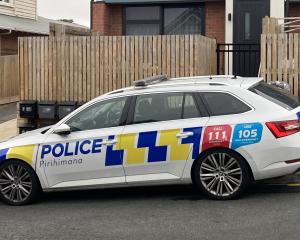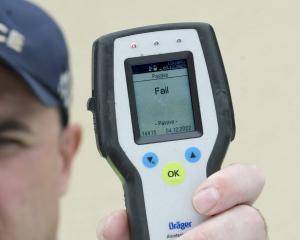Changes to State Highway 1 through Dunedin could cause congestion in the city centre if they are not done properly, the Otago branch of the Automobile Association says.
The NZ Transport Agency yesterday released two proposals for downtown Dunedin traffic flows that would cost at least $100 million, but could also help support the soon-to-be built Dunedin Hospital — and the agency says — "more options for vehicle-free travel".
The two options proposed are:
- Keeping the twin one-way streets State Highway 1 layout through the central city, or
- Turning the existing southbound Castle St one-way State Highway into a 50kmh two-way highway and the existing Cumberland St one-way state highway into a two-way 30kmh local road with cycle lanes.
Yet, AA Otago District Council chairman Malcolm Budd said the association had yet to see the work done to forecast changes to travel times through the city, or evidence the new street network would be able to move as much traffic through the city, from the north or south.
"There’s no point in doing it and finding it’s not going to work," he said.
"It’s a major decision for Dunedin to make — if they don’t get it right it could cause congestion right through the city — even getting across east to west, west to east."

The arterial route would begin at the Andersons Bay Rd intersection, turn on to Strathallan St, Wharf St, Thomas Burns St, to the overbridge on to Anzac Ave then either travel back on to the state highway heading north via Frederick St, or turn towards the port at Port Chalmers.
The main east-west route on St Andrew St would be moved to Frederick St.
In the two one-way highways option a slow-speed zone (30kmh-40kmh) would be introduced on both current northbound and southbound routes.
Spokes Dunedin chairman Jon Dean said dealing with congestion had "nothing to do, in the most part, with the configuration of the road" but was because "there’s too many cars".
"The reality is we want a transport network that is designed for getting people from where they are to where they want to be.
"And I don’t care what sort of person that is, and I don’t care how they get there — but it has to be efficient," Mr Dean said.
"And as a cycle advocate we think cycling is part of a mix of solutions that make the transport network more efficient — but cyclists, being a vulnerable user, need the network to be safe and efficient."
Otago Regional Council operations general manager Gavin Palmer said public transport was part of the solution — encouraging bus use could include upgrading important bus stops, connecting with a park ’n’ ride, or creating bike hubs near important bus stops
At present about 75% of the traffic movement into the city centre for work was cars and NZTA regional relationships director Jim Harland said "part of the thinking was to see if we can get that number to drop off while still providing a reliable service".
"And linked to that is a more attractive streetscape for people to walk on or cycle on — and also a safer central city environment.
"All of the options for improvements, when you look at them together, even the cheapest ones are more than $100million.
"But then you’ve got to look at the benefit side."
The "bones" of the 50-year-old transport network in Dunedin were good, the former Dunedin City Council chief executive said, but "it’s a question of how it’s configured and when it was originally conceived people weren’t thinking too much about cycling or walking".
The city council’s Dunedin central city plan states "severance caused by the one-way system" is a challenge for the city.
It notes another challenge is Dunedin residents’ "resistance to change".
"Many retailers, in particular, remain resistant to change, concerned that changes could weaken the central city, rather than improve it. They are fearful that unproven changes will affect their businesses negatively and want to minimise risk as much as possible," it says.
The project is using online tools to engage with the public including a platform that allows users to add their thoughts for consideration.
At 7.15pm yesterday the idea that had received the most "likes" was that "a multistorey car parking building would be pivotal to the success of the hospital".
"Dunedin already lacks parking spaces, and either an underground or above-ground car park would be a big help," the commentor wrote.
Several commentors asked for added pedestrian crossings in certain streets, and some pointed out areas that were particularly well-used by cyclists.
The initial stage of this project, the delivery of the programme business case, is estimated to cost $450,000.
Timeline
- June 2020: public engagement.
- Second half of 2020: further community feedback.
- End of 2020: programme business case completed.
- 2021: design, consenting, procurement work and any physical work needed to align with early new hospital build works.
- Post-2021: substantive project work to start.
Source: NZTA
Comments
Even worse, this council have decided that this is the best time to 'look at the way we travel in Dunedin'...They want to include their fruitcake cycling ideas and assumptions that every citizen in Dunedin LOVES walking, and prefers that to driving....I live in Allanton and the very concept of walking to Mosgiel to catch a bus and then walking from the bus stop to my place of work, ISN'T that appealing at ANY time of year, let alone winter!
We will have congestion, no doubt about it! But that's exactly what the council want.....Then they can simply tell us to walk, bike or use the bus. It's ALL part of their plan to force Dunedinites out of their cars!
The statement "congestion had 'nothing to do, in the most part, with the configuration of the road' is just the sort of thinking that will lead to problems. Even with the qualification, it is quite wrong. The first iteration of the one way system was introduced so long ago (1968) that the congestion prior to its introduction has largely been forgotten. The change improved average travel speeds between Stuart and Rattray Streets from 17kph to 30kph at evening peak, and 26kph to 40kph at off peak.
Another $450k for "consultants" to fill their back pockets and come up with a totally ridiculous plan that will cost millions to put into action ... and ten times the cost to do remedial work once they find out it doesn't work.
There is only one serious option offerred and that is option one. This option at least allows the posibility to move some traffic to an alternate route.
The idea that you improve trafic flow by removing lanes is simply absurd.
Despite the greens preferences, traffic will continue to grow in Dunedin. The greens can block off as many shopping precints as they want, it still won't enable pensioners from Maori Hill to cycle into town to buy their groceries.
And why would roads be closed down to make the new hospital build easier? They can just utilise the land they have just like any other construction site. The hospital group think they are special. They aren't. They are just like any other developer wanting to do things as cheaply as possible and ignoring impact on everyone around them.
"It notes another challenge is Dunedin residents’ "resistance to change"
""Many retailers, in particular, remain resistant to change"
So the DCC are effectively making out that the ratepayers are the bad guys here.
The only "resistance" ratepayers have is paying money for cockamamie ideas from this "council" when they should be spending money on essential things, roads, drainage etc and not on greenie ideological pursuits.











